
views
A tax slab essentially dictates the amount of tax that an individual or business is required to pay according to their income. In the Interim Budget 2024-25, Finance Minister Nirmala Sitharaman proposed no changes in the tax structure, direct or indirect. This means income tax slabs under the new regime as well as the old regime remain the same as were announced in Union Budget 2023-24. Catch LIVE updates on Interim Budget 2024 here.
Key highlights of the new system include an elevation in the basic exemption threshold and enhanced tax rebates. Taxpayers have the option to choose between the previous tax regime and the updated one.
The modifications were specific to the new tax regime, leaving the old tax regime unchanged. Despite the new tax regime becoming the default option starting from 2023-24, taxpayers retain the flexibility to select the old one if they prefer.
Choosing between the new and old tax regimes can be tricky, especially with the differences in tax slabs. Let’s break down the key points to help you understand:
Old Tax Regime
Slab structure:
- 5%: From Rs 2.5 lakhs to Rs 5 lakhs
- 20%: From Rs 5 lakhs to Rs 10 lakhs
- 30%: Above Rs 10 lakhs
- In the old tax regime, there are seven tax slabs, with the liability going from NIL to 30 per cent of the income.
- People with an annual income of up to Rs 2.5 lakh are exempt from paying income tax.
- Those earning between Rs 2.5 and 5 lakh have to adhere to a tax rate of 5 percent.
- For people whose yearly income falls from Rs 5 lakh to 7.5 lakh, the income tax rate is at 10 percent of the total earnings.
- Individuals in this bracket have an annual income of Rs 7.5 to 10 lakh. The tax rate for them is 15 percent.
- For income ranging from Rs 10 to 12.5 lakh per year, the tax rate is 20 percent.
- Those earning between Rs 12.5 and 15 lakh have to follow a tax rate of 25 percent.
- For annual income exceeding Rs 15 lakh, the tax rate is 30 percent.
Under the new income tax regime, the number of slabs has been reduced.
Slab structure:
- 0%: No tax on income up to Rs 3 lakhs
- 5%: From Rs 3 lakhs to Rs 6 lakhs
- 10%: From Rs 6 lakhs to Rs 9 lakhs
- 15%: From Rs 9 lakhs to Rs 12 lakhs
- 20%: From Rs 12 lakhs to Rs 15 lakhs
- 30%: Above Rs 15 lakhs
Surcharge: Applies to certain income brackets:
- 10%: Above Rs 50 lakhs
- 15%: Above Rs 1 crore
- 25%: Above Rs 2 crore (reduced from 37% in 2023)
- Those who earn up to Rs 3 lakh a month have to pay no income tax.
- Annual income ranging from Rs 3 to 6 lakh will invite a tax rate is 5 percent.
- However, a tax rebate is applicable for income earned upto Rs 7 lakh, making it tax-exempt as well.
- Those earning between Rs 6 lakh and Rs 9 lakh a year have to follow a tax rate of 10 percent.
- The tax rate for a yearly income of Rs 9 lakh to Rs 12 lakh has been set at 15 percent.
- For the next tax bracket, which covers annual income of Rs 12 lakh to 15 lakh, the tax rate is 20 percent.
- The last tax slab covers all those whose yearly income exceeds Rs 15 lakh. They have a tax liability of 30 percent.
New vs Old Tax Regime: Which Tax Regime Is Better?
The best regime for you depends on your income, investments, and deductions. If you have a simple income structure and limited deductions, the new regime might be more beneficial. However, if you have significant investments or claim many deductions, the old regime might save you more tax.
It’s recommended to consult a tax advisor to determine the most suitable regime for your circumstances.




















Comments
0 comment